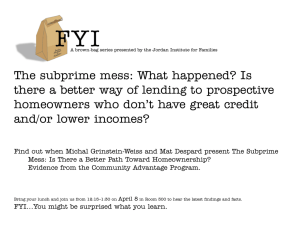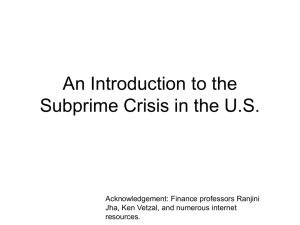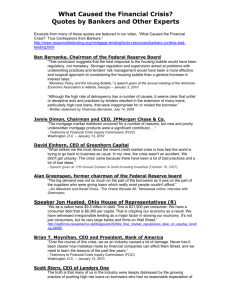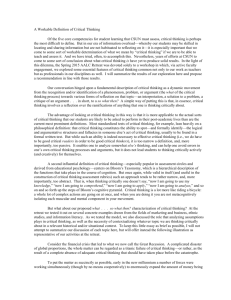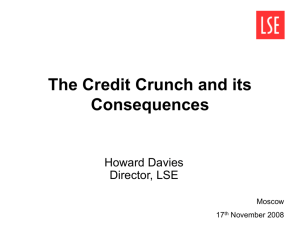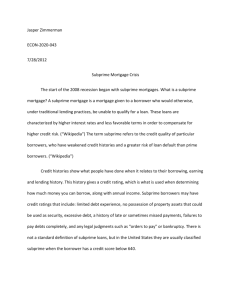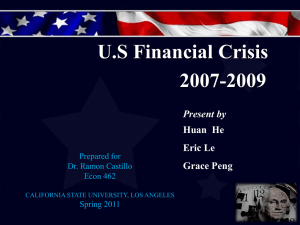The Great Capital Strike
advertisement
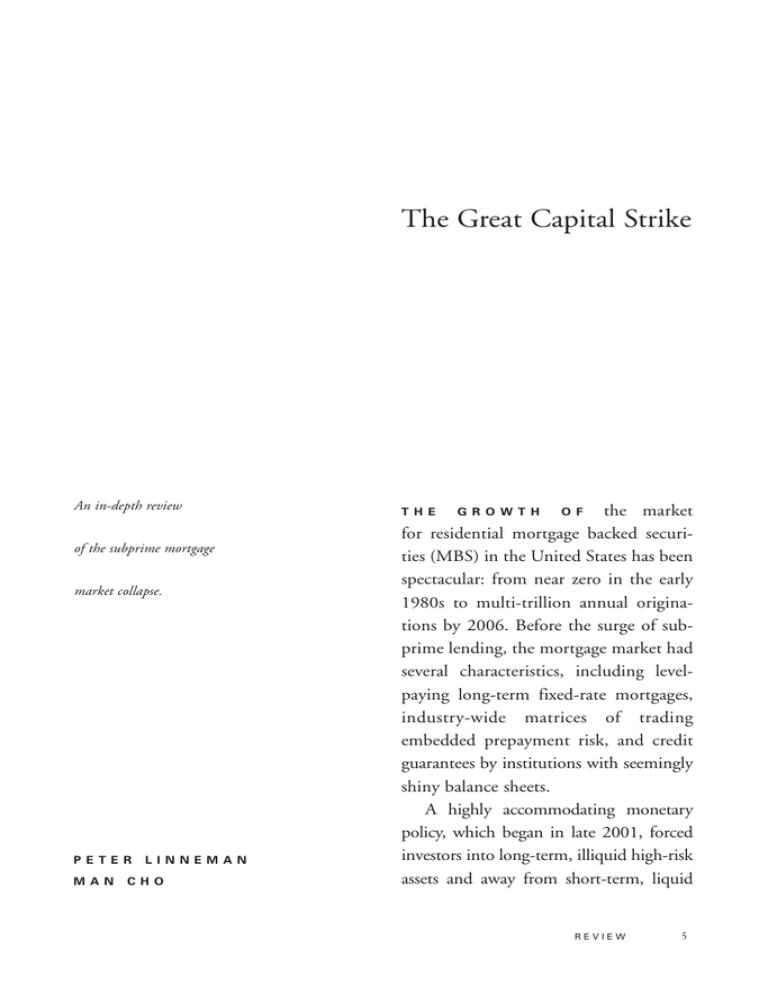
The Great Capital Strike An in-depth review of the subprime mortgage market collapse. PETER MAN LINNEMAN CHO G R O W T H O F the market for residential mortgage backed securities (MBS) in the United States has been spectacular: from near zero in the early 1980s to multi-trillion annual originations by 2006. Before the surge of subprime lending, the mortgage market had several characteristics, including levelpaying long-term fixed-rate mortgages, industry-wide matrices of trading embedded prepayment risk, and credit guarantees by institutions with seemingly shiny balance sheets. A highly accommodating monetary policy, which began in late 2001, forced investors into long-term, illiquid high-risk assets and away from short-term, liquid T H E REVIEW 5 low-risk investments. In short, the “search for yield” created by the Fed’s negative real short-term rates pushed many investors into long-term debt markets, with which they had little experience. Equipped with ample liquidity via cheap short-term debt, many investors played the yield curve with mismatched assets and liabilities, often cutting corners on due diligence. In fact, some investors appear to have relied solely on rating agencies and security issuers to make their investment decisions. These “moremoney-than-brains” investors sought seemingly free yield premiums from longterm, illiquid and highly risky assets. Some investors in search of yield rushed into the previously profitable niche market of subprime mortgage funding. The search for yield created a perverse incentive for lenders to make ever-riskier residential loans at tighter spreads. As a result, between 2003 and 2006, underwriting quality deteriorated dramatically. This is demonstrated by the increasing shares of “exotic” loan products, such as 2/28 or 3/27 option-ARMs (adjustable rate mortgages) and forty-year ARMs. These products were new to the market, had not been vetted by any real economic stress, and were frequently overlaid with other risk factors, such as high-LTV, lowFICO scores, and low-/no-documentation requirements. Funding these loans via securitization was done with shaky tech- 6 ZELL/LURIE REAL ESTATE CENTER niques for measuring and managing mortgage credit risk, using unreliable performance data, lacking dependable theory on some of the key measurement analytics. On top of this, multiple rounds of securitization to create complex and arcane securities exacerbated the problem of information asymmetry between MBS issuers and investors. As the economic environment changed, “trust” among investors quickly evaporated, and four to five years’ worth of lending came to a crashing end. As the Fed increased short rates, spreads narrowed and in order to maintain pro forma returns on equity many financial institutions simply raised their leverage via off-balance-sheet structured investment vehicles. As delinquencies rose, and asset prices dropped, heavy leverage crushed the thin equity positions of many lenders. Worse, a fundamental lack of transparency meant that no one knew for sure who held what assets at exactly what leverage levels. This caused an erosion— and ultimately a collapse—of confidence in the financial condition of capital market players. Mismatched lenders such as Bear Stearns, Lehman Brothers, AIG, Fannie Mae and Freddie Mac could neither borrow nor sell their illiquid assets, and suffered catastrophic margin calls. Their problems were exacerbated by the application of mark-to-market marks to assets with no markets. The result was mark-to“pawnshop” valuations. With 20:1, often exceeding 30:1, leverage ratios, equity cushions were quickly crushed by the confluence of falling values, low marks, and huge bid-ask spreads on illiquid mortgage security tranches. Subprime borrowers had traditionally been cash income earners such as taxi drivers, gardeners, and small store owners. Savvy subprime lenders understood that these borrowers generally had greater resources than reported in their loan applications, since they underreported cash earnings for tax purposes. Consequently, these lenders were willing to pay 100 to 200 basis point premiums for waiving the conventional formulas for income and other underwriting factors. Beginning in 2003, however, a new sort of investor flocked to subprime loans in order to acquire homes for future capital gains. “Get-rich-quick households” bought “investment” homes and condos; their goal was to own for just a few months before selling. Such buyers represented a large share of subprime borrowers in the latter part of the housing boom. Many of these buyers were so-called “empty-roof” speculators who bought unbuilt residential properties. There is growing evidence that these borrowers played a significant role in both the boom and bust of the housing and subprime mortgage markets. The government-sponsored mortgage funding model that had endured for more than two decades collapsed on September 9, 2008 when the federal government injected $200 billion of preferred stock into Fannie Mae and Freddie Mac, making the implicit U.S. government guaranty explicit. More broadly, asset securitization, often called the Originate-to-Distribute model, is under attack, and a series of new policy measures is likely to be introduced. Some of the major problems include adverse selection (or cherry-picking) in loan sales by primary market lenders; overleverage by secondary market conduits and other financial institutions, often motivated by implicit government guarantees or the Too Big to Fail principle; and extreme boom-bust cycles in asset and security markets fueled by cheap liquidity and false signs of high risk-adjusted returns. In short, to end the Great Capital Strike it is necessary to regain investor confidence and restore the stability of the mortgage finance system with a new regime of soundness controls. RISE AND FALL Before the 1980s, mortgage lending was dominated by savings and loans (S&Ls) and thrifts. The funding side of their businesses was predominantly provided by their deposit bases. However, a series of economic events since the 1980s fundamentally changed the mode of mortgage funding in the United States. First, high REVIEW 7 inflation and the prolonged inverted yield curve of the early 1980s, coupled with stiff competition from money-market mutual funds in attracting small savers, triggered the large-scale failure of the S&Ls. There were efforts on the part of the federal government to save S&Ls, such as the deregulation of deposit-rate ceilings in the early 1980s, an ill-conceived attempt that merely incentivized S&Ls to gamble on recovering real estate markets and prolonged the crisis. Ultimately, the crisis resulted in the fall of S&Ls in large numbers. The final taxpayer bill exceeded $180 billion. The vacuum in mortgage funding created by failed S&Ls was gradually filled by government-sponsored enterprises (GSEs) and Ginnie Mae, the government-run funding agency. The MBS market grew steadily during the 1980s and 1990s, with its share in total origination reaching over 50 percent. The success of this GSEdominated funding model not only inject- ed the needed liquidity into the primary market, which in turn helped raise home ownership rates, but also created a large and liquid international MBS market. As the market for MBS grew, the GSEs’ underwriting guidelines fragmented the U.S. mortgage market. As shown in Figure 1, conventional loans (that is, loans without a government guarantee) were divided into two segments: those that complied with the GSE’s underwriting guidelines, called “conforming” or “A” loans; and those that did not, called “nonconforming” loans. Eligibility essentially reflected loan characteristics such as the maximum allowable loan-to-value (LTV) and debt-to-income (DTI) ratios, acceptable borrower credit scores, documentation requirements, and interest rate variability. The non-conforming segment was divided into two groups, non-prime and jumbo loans. Non-prime loans, originally called “B&C” loans, incorporated sub- Figure 1: Segmentation of the U.S. mortgage market A. Government Insured (FHA/VA) B. Conforming Conventional C. Non-prime (e.g., B&C) Non-conforming D. Jumbo A. B. C. D. 8 Government-insured (FHA/VA): Explicit government guarantee; securitized by Ginnie Mae Conforming conventional: Implicit government guarantee; securitized by GSEs Non-conforming non-prime: No government guarantee; securitized by private-label (PL) MBS issuers Non-conforming jumbo: No government guarantee; securitized by PL MBS issuers ZELL/LURIE REAL ESTATE CENTER prime and Alt-A mortgages. Jumbo loans were those that exceeded the size of the regulatory loan limit. The widely publicized accounting scandals at Freddie Mac (in 2003) and Fannie Mae (in 2004) changed the landscape in mortgage funding away from GSEs toward private MBS issuers. Those private funding institutions were mostly investment banks and large commercial banks, such as Lehman Brothers, Bear Sterns, JPMorgan, Goldman Sachs, Bank of America, and Wells Fargo, and major mortgage lenders such as Countrywide, Washington Mutual, and Indy Mac. The competition between GSEs and the private MBS issuers began in the early 1990s. Private MBS issuers even formed a trade organization, called “FM Watch,” as a vehicle to lobby Congress for limiting the government-sponsored enterprises’ role in the mortgage finance industry. Meanwhile, the GSEs ran perhaps the most efficient political lobbying machine in U.S. history, with powerful allies on both sides of Congressional aisles, many of whom even received “VIP mortgages” from originators. Mortgage products in the subprime market are predominantly adjustable-rate mortgages (ARMs), in contrast to fixedrate mortgages in the prime market. “Exotic” subprime ARMs have special features such as interest-only ARMs, option ARMs (for which borrowers have several options to choose in each payment node, including a negative amortization of principal), hybrids that usually have belowmarket interest rates and non- or negatively amortizing principal during the first two to three years of loan life, and 40-year maturity ARMs. These exotic mortgage loans gradually increased their shares in total subprime origination between 2002 and 2006. These loans are issued to those borrowers with very low FICO scores and/or with non-conforming documentations. Compared to other segments, subprime ARMs exhibit a higher LTV on the average (low 80s vs. low 70s) and a higher share of second-lien mortgages. Between 2002 and 2006, exotic mortgage loans increased their shares in total subprime origination. In terms of securitization, the collateral in the conventional market consists predominantly (over 90 percent) of fifteenyear and thirty-year fixed-rate mortgages with level-paying fully amortizing principals and no prepayment penalties. These “plain vanilla” mortgages have a low degree of uncertainty in projecting postorigination mortgage cash flows compared with other products. From a risk management point of view, three pillars prop up the prime-MBS market. First, prepay-tranching—that is, the segmentation of a mortgage pool into multiple tranches with different levels of prepayment risk. Planned amortization REVIEW 9 Table I: Description of RMBS categories PRIME MORTGAGE CHARACTERISTICS Lien Position JUMBO ALT-A SUBPRIME 1st Lien 1st Lien 1st Lien Over 90% 1st Lien Weighted Average Low 70s LTV Low 70s Low 70s Low 80s Borrower Credit History No credit derogatories No credit derogatories No credit derogatories Credit derogatories Conforming to Agency Criteria Conforming Conforming by all standards but size Non-conforming due Non-conforming to documentation due to FICO, or LTV credit history, or documentation 65%-80% 70%-100% 60%-100% ABS ABS, CDO CDO-squared ABS, CDO CDO-squared Loan-to-Value(LTV) 65%-80% SECURITIZATION ATTRIBUTES MBS Products Pass-through CMO Collateral Predominantly Mixed with ARMs FRMs (15-30 yrs) and FRMs Mixed with ARMs and FRMs Predominantly ARMs w/ “exotic” features Credit Enhancement External CE Internal, “6-pack” CE Internal, “6-pack” CE Internal, XS/OC Risk Indicators Prepay-OAS G-fee N/A Credit-OAS (being developed) Credit-OAS (being developed) Issuers GSEs Private label issuers IBs & large CBs IBs & large CBs Source: Gorton (2008); Cho (2008) class – CMO (Collateralized Mortgage Obligation) mortgages, first introduced in the mid-1980s, were a milestone in gaining the confidence of the investment community. The mortgage finance industry also embraced option-adjusted spread, developed by Salomon Brothers in 1986, as a primary tool for measuring riskadjusted return from collateralized mortgage obligation tranches. To date, the option-adjusted spread statistics are widely used in the performance-tracking reports issued by the prime MBS dealers. Monthly disclosure by MBS issuers to investors, on every fourth business day of each month, 10 ZELL/LURIE REAL ESTATE CENTER shows marked-to-market risk indicators for each MBS deal. The subprime MBS, on the other hand, is structured to control default risk, that is, “credit-tranches” have different degrees of loss protection. Since there is an information asymmetry between lenders/issuers and investors in assessing embedded risks of the deal, tranching reveals the risk-return trade-offs investors can expect. But this attribute is premised upon perfect information, and an imperfect estimate of underlying loan performance will affect the sizing of tranches, and realizing risk-adjusted return. Subprime MBS often involves multiple rounds of securitization. The first round is to package a pool of mortgages into an ABS deal. There are three ways to control the embedded default risk through structuring the deal: subordination, excess spread, and over-collateralization. Typical subordination in ABS trading takes a socalled “six-pack” structure: that is, the senior (or AAA) tranches in the deal are protected by three mezzanine tranches and three junior tranches. The second round is the re-securitization of ABS tranches into similar collateralized debt obligation (CDO) deals. There is yet another layer of securitization, pooling mezzanine CDO tranches. Although senior tranches were favored by conservative investors (pension funds) and junior tranches by aggressive investors (hedge funds and foreign investors), middle tranches did not generate strong demand. Hence, the MBS issuers re-packaged the mezzanine tranches and re-created senior and junior tranches with different subordination levels from original CDOs. The niche market of subprime lending saw loan originations explode from about $190 billion in 2002 to more than $500 billion in both 2005 and 2006 (Figure 2); subprime lending has since dropped to its pre-2003 level of roughly $160 billion in 2007. On the funding side, the ABS CDO market grew from virtually zero in 2001, to $261 billion in new issuance in 2006. This rapid growth was achieved without Figure 2: Subprime mortgage origination 1994-2007, constant U.S. 2000 $ 600 549 540 512 483 480 420 $ Billions 360 288 300 240 191 180 158 120 60 0 1994 1995 Source: Jaffee (2008) 1996 1997 1998 1999 2000 2001 Year 2002 2003 2004 2005 REVIEW 2006 2007 11 industry-wide best practices for measuring and disclosing the embedded risks. The industry practice was different in the prime MBS market, which had been utilizing option-adjusted spread as a key measurement tool along with the monthly disclosure requirements of mark-to-market risk factors by MBS issuers to investors. The subprime ABS collateralized debt obligations, which grew the most rapidly of any segment of the collateralized debt obligation market since the early 2000s, has seen virtually no new issuance in 2008 or 2009. The rapid rise, and equally rapid demise, of the subprime MBS market is reflected in declining ABX prices, which reflect the price of the credit risk borne by subprime collateralized debt obligation tranches. As Figure 3 shows, the values of collateralized debt obligation tranches fell rapidly beginning in 2007. By the end of July 2008, prices were 89 cents on the dollar for AAA bonds, or a 10 percent haircut. However, the prices for BBB tranches were only 10 cents, a whopping 90 percent haircut! These price declines coincided with the following milestone events: the precipitous drop in the price of New Century, one of the largest subprime lenders, in February 2007 (New Century went under two months later); HSBC’s report of $10.5 billion in credit losses in February 2007; the termination of hedge Figure 3: Trends of 2007—ABX indices and milestone events (daily, 1/2/2007 to 9/2008) 100 AAA 80 AA New Century’s share value crash 60 Hedge fund closures by BNP-P and Bear Stearns 40 AA Fitch and S&P’s CDO ratings downgrading 20 BBBBear Stearns merge to JP Morgan Chase 0 Jan Feb Mar 07 07 07 Apr May 07 07 Jun 07 Jul 07 Aug 07 Sep Oct Nov Dec 07 07 07 07 Source: www.markit.com 12 ZELL/LURIE REAL ESTATE CENTER Jan 08 Feb Mar 08 08 GSE’s share value crash Apr May Jun 08 08 08 Jul Aug 08 08 Sep 08 Figure 4: 60+ days delinquency rate of subprime loans, by origination vintage 30.0% 25.0% 20.0% 15.0% 10.0% 5.0% 0.0% 1 3 5 7 9 2003 Originations 11 13 15 17 19 2004 Originations 21 23 25 27 29 2005 Originations 31 33 35 37 39 2006 Originations 41 43 45 47 49 2007 Originations Source: Freddie Mac funds operated by Bear Stearns in June 2007, as well as those managed by BNP Paribas in August 2007; an exodus of ABCP investors from the short-term financing market for subprime collateralized debt obligation issuers in September 2007; large-scale collateralized debt obligation bond ratings downgrades in October and November 2007; the acquisition of Bear Stearns by JP Morgan, assisted by the Fed’s emergency funding, in March 2008; emergency liquidity support for Fannie Mae and Freddie Mac by the Fed, and new GSE legislation enacted in July 2008; bankruptcy filing by Lehman Brothers, a merger with Merrill Lynch by Bank of America, the nationalization of GSEs, and the bailout of AIG in September 2008. Subprime originations reveal deteriorating underwriting quality during the subprime mortgage lending boom. For example, between 2001 and 2006, the share of risky loan products in new originations rose from 0 percent to 23 percent for interest-only ARMs, from 28 percent to 51 percent for low- or no-documentation loans, and from 0 percent to 5 percent for forty-year ARMs. Not surprisingly, loan performance was much worse for this period. After controlling for loan seasoning, the 2006 and 2007 origination cohorts of subprime loans exhibit far higher delinquency rates than those originated in the earlier years (Figure 4). REVIEW 13 MORE MONEY THAN BRAINS The real Fed Funds rate was negative from 2002 to 2005 (Figure 5), rendering shortterm safe assets a guaranteed loss proposition. (The only other time in the last forty years when there was such a sustained period of negative real return was from 1974 to 1976, a period followed by a fiveyear run of sharp home price growth [1976-1980] and, subsequently, by negative real home price appreciation from 1980 to 1984.) As investors fled from the sure losses on short-term low-risk assets, they looked for a “free lunch;” that is, a higher return at seemingly comparable risk requiring little underwriting expertise. This negative real rate on low-risk short-term investments was effectively an edict by the Fed requiring investors to invest long and risky, while borrowing short. The edict created a ticking time bomb. This was particularly true as many formerly short-term, low-risk investors were not experienced in long-term, risky investments. Financial institutions were encouraged to aggressively play the yield curve, using short-term repo loans to purchase long-term illiquid assets that offered extra yield. Short-term financing rollover Figure 5: Real and nominal Fed Funds Rates, 1970 to current 20.0% 15.0% 10.0% 5.0% 0.0% 1970M1 1970M1 1971M1 1972M1 1973M9 1974M8 1975M7 1976M6 1977M5 1978M4 1979M3 1980M2 1981M1 1981M1 1982M1 1983M1 1984M9 1985M8 1986M7 1987M6 1988M5 1989M4 1990M3 1991M2 1992M1 1992M1 1993M1 1994M1 1995M9 1996M8 1997M7 1998M6 1999M5 2000M4 2001M3 2002M2 2003M1 2003M1 2004M1 2005M1 2006M9 -5.0% Source: www.markit.com 14 ZELL/LURIE REAL Real Fed Funds Rate ESTATE CENTER Nominal Fed Funds Rate seemed a sure thing, so mismatched duration did not trouble these institutions. But once the Fed raised rates and the yield curve flattened and ultimately inverted, this game was over; repo loans were called, and illiquid long assets were proven to be very illiquid. This caused the unraveling of intentionally non-transparent liabilities, as we discovered (and are still discovering) hidden liabilities such as structured investment vehicles and collateralized debt obligation. Heavy leveraging, mismatched duration, and nontransparency have killed these institutions as we shifted from a steep to flat yield curve, and negative to positive short real rates. Low rates and bailouts will not solve the problem, as continued nontransparency makes everyone hesitant because no one knows who holds the losses. With the Fed’s encouragement, excessive risk-taking worsened over time. Many prime lenders became subprime lenders and MBS issuers of subprime loans, which looked to novices like the same risk for higher returns. A set of acronyms arose to describe these products, including NINA (no-income-noasset), SISA (stated-income-and-statedasset), and NINJA (no-income-no-joband-asset). All these products were attempts to obtain a few more basis points of return, turbo-charged into double-digit returns by loads of extremely cheap short-term debt. There were two economic trends that promoted the asset market booms: the sustained strong home price growth from 1998 to 2006 and a highly accommodating monetary policy in the early 2000s. The level of home price appreciation, which was several multiples higher in terms of total appreciation than in prior booms, created a perception of long-run price growth and a mania for housing investment. That, in turn, increased the demand for those subprime mortgage products, such as option ARMs, that could be used for purchasing investment properties. Monetary policy is another systemic factor that contributed to the housing price boom. Between 2002 and 2005, the real Fed Funds Rate was negative (Figure 5). During this period, the spread between one-year and ten-year Treasuries was 250 to 300 basis points, inviting the so-called “yield curve play” among institutional investors, who borrowed in a short-term money-market by issuing ABCP and other products with short maturities, while investing in long-term securities such as subprime MBS. Wall Street investment banks played this game, serving not only as issuers of collateralized debt obligations and CDO2, but also as active investors through direct acquisition of securities and affiliated hedge funds. There has been only one time in the last forty years when the real Fed Funds REVIEW 15 Table II: NRSRO companies and SEC approval years NRSRO Approval year Moody’s 1975 Standard & Poor’s 1975 Fitch 1975 Dominion Bond Rating Services 2003 A.M. Best 2005 Japan Credit Rating Agency 2007 Rating and Information, Inc. 2007 Egan-Jones 2007 Lace Financial 2008 Realpoint 2008 Source: Securities and Exchange Commission Rate turned negative for several years, the mid- to late-1970s. But that national housing boom began with depressed housing prices. The 2003 to 2006 housing boom, on the other hand, started in the middle of an already strong market. In the secondary market, private-label MBS issuers (mostly investment banks) created highly non-transparent and hardto-price debt securities. Investors in repackaged securities relied heavily on the credit ratings of Moody’s, Standard & Poor’s, and Fitch. In 1975, the Securities and Exchange Commission had established the Nationally Recognized Statistical Rating Organization (NRSRO) as a quality control mechanism, and immediately approved the three main agencies (Table II). No more rating companies were approved until 2003. Although there are now ten NRSROs with seven new firms 16 ZELL/LURIE REAL ESTATE CENTER entering after the Enron crisis, the Big Three still dominate the industry. There is growing evidence that the underlying assumptions used in rating subprime asset-backed securities and collateralized debt obligation deals did not change over time, in spite of deteriorating collateral quality. For example, the normal and stress losses from typical subprime mortgage pools were held constant until late 2007, at which point the agencies suddenly downgraded subprime MBS tranches in large quantities. In consequence, the “more money than brains” investors in subprime securities—who heavily relied on bond ratings in lieu of proper due diligence on collateral—forced fire-sales of these securities or worsening balance sheets caused by marked-down security values. E M P T Y- R O O F BORROWERS According to the New York Fed, in August 2008 there were about 952,000 non-performing subprime loans out of roughly three million subprime loans issued between 2004 and 2007. These non-performing loans were sixty or more days delinquent, in foreclosure, or owned by lending institutions. Official statistics maintain that the share of nonresident subprime borrowers is only about 10 percent. But since such borrowers often do not disclose their real reasons for borrowing, this number is suspect. Although there is no accurate data, we suspect that a large proportion of subprime borrowers were investorborrowers and empty-roof borrowers. Even as all other risk attributes in subprime lending deteriorated, the consumer credit scores of subprime borrowers actually improved, which suggests that many of them were investor-borrowers. The number of subprime borrowers with FICO scores below 580 decreased among new originations, while borrowers with scores above 659 increased (Figure 6). The structure of subprime loans, such as 2/28 option ARMs, nicely fit the needs of investor-borrowers, in that they had minimal payments due before they flipped the properties, which usually happened in six to eighteen months. Investor-borrowers viewed the contractual bump-up in rates as irrelevant, since they expected to repay the loan well before the rate reset. We believe that most investor-borrowers, especially of unbuilt properties, ruthlessly exercised their default option and defaulted on their mortgage obligations when they realized that their equity was deep under water. This included speculative units that were being rented, since the Figure 6: FICO distributions among subprime borrowers (new origination) 40 35 30 25 20 15 Below 580 2007 2006Q4 2006Q3 2006 2006Q2 2005Q4 2005Q3 2005 2005Q2 2004Q4 2004Q3 2004 2004Q2 2003Q4 2003Q3 2003 2003Q2 2002Q4 2002Q3 2002 2002Q2 2001Q4 2001Q3 2001 2001Q2 2000Q3 2000Q4 2000 2000Q2 10 GT 659 REVIEW 17 rental payments usually failed to cover taxes, operating costs, and mortgage payments. A recent study shows that the probability of default for subprime products such as option ARMs that are incentivecompatible to empty-roof borrowers can reach to 70 percent under a stress home price scenario. In its October 2008 Global Financial Stability Report, the International Monetary Fund estimated $1.4 trillion in potential write-downs for the U.S. financial sector. Among these write-downs, losses from subprime/Alt-A mortgages and securities represent 41 percent (or $585 billion out of the $2.4 trillion outstanding), whereas those from prime mortgage and securities are only 12 percent ($165 billion out of $7.6 trillion outstanding). The balance of the losses comes from commercial real estate, credit card, and corporate lending sectors. However, about 55 percent of the total write-downs cited above are mark-to-market devaluation, which leaves only about $260 billion default-driven credit losses from the subprime and Alt-A mortgage market. These estimates under-predict credit losses from subprime and Alt-A lending. As a back-of-the-envelope calculation, we apply a 50 percent share of nonresident speculative borrowers in the subprime-Alt-A mortgage market, a 50 percent default rate to these loans, and a mere 40 percent recovery rate. The 18 ZELL/LURIE REAL ESTATE CENTER resulting losses from subprime-Alt-A flippers would amount to $360 billion. On the other hand, loans issued to conventional resident subprime borrowers will experience lower default and loss rates, for which we apply a 10 percent default rate and 60 percent recovery, resulting in about $36 billion in losses from this borrower cohort. We predict the expected losses from all mortgage borrowers will be $396 billion, about one and a half times higher than the International Monetary Fund estimate. Four regions exhibit very high residential mortgage delinquency rates: California-Nevada-Arizona; Massachusetts/ New England states; Florida; and Ohio/Michigan. Subprime borrowing by speculative home buyers was rampant from 2003 to 2006 in three of these areas (Ohio/Michigan was the exception). For example, Miami typically absorbs 1,000 condos annually, yet 40,000 units were under construction in 2007. While future studies will precisely document the magnitude of speculator buying, it is likely that subprime lending amplified housing appreciation. That is, subprime lending accelerated home price growth during the boom, as housing demand was artificially fueled by empty-roof speculators; subprime lending also deepened home-price declines, as empty-roof units came on the market, further depressing home prices. THE GREAT CAPITAL STRIKE How did banks and other lenders prepare themselves for an economy-wide systemic risk event such as Great Capital Strike? The answer is “poorly.” Instead of realizing returns via underwriting ability, they manufactured returns via leverage, using ever more debt to offset narrowing fundamental margins. As short rates fell, lenders played the yield curve with mismatched leverage. As the yield curve flattened, they added even more nontransparent leverage to offset the narrowing spread margin, and went even longer and more illiquid to pick up additional yield. When the day of reckoning came, they could not sell illiquid long assets due to large bid-ask spreads on them. Values of long risky assets declined, and forced sales occurred. The game of ever-increasing hidden leverage came to an end. High and non-transparent leverage has undermined investor and lender confidence about how risky and levered everyone is, setting the stage for the massive debt pullback in September and October 2008. When greed turned to fear, investors fled to quality, causing the prices on all risky assets to plunge. Stated differently, when investor risk sentiment shifted, almost all asset returns became very highly correlated, with their “betas” temporarily approaching one. The trigger was the Fed raising rates to 5.25 percent, and the yield curve inverting; as investors could once again realize attractive real returns by holding short and safe assets, they no longer needed to go long and risky. The inevitable time bomb exploded, producing the Great Capital Strike. Another trigger was the massive and deep downgrading of subprime bond ratings, which began in October and November 2007. Figure 7 shows the speed and depth of the bond downgrading in the case of one collateralized debt obligation deal issued by Goldman Sachs (GSAMP Trust 2006-S3) in April 2006. Initially, the deal had twelve tranches, including three senior pieces and two tranches rated BB+ and BB. After about one and a half years, six of the lowest grade segments were completely written off as credit losses, and three mezzanine tranches were downgraded to junk. Only three AAA tranches remained investment grade, now with BBB ratings. According to Moody’s, the historical probability of AAA bond being downgraded to BBB within two to three years from issuance is about 0.04 percent. In the case of subprime collateralized debt obligations, more than 3,000 subprime tranches experienced deep downgrading during October 2007 alone. New issues of subprime and other ABS went virtually to zero in the second half of 2008, from more than $1 trillion annual volume in 2006, although it slightly increased in 2009 due REVIEW 19 mainly to the TALF (Term ABS Liquidity Facility) and other government initiatives (Figure 8). The Great Capital Strike will end only when investor confidence is restored. To that end, new mortgage funding channels with greater transparency are needed. Complete transparency about current assets and liabilities—not bailouts—is required to restore confidence. Also, federally insured depositories must be forced to reduce their leverage and be subjected to more stringent supervision and disclosure requirements. The well-documented incentive problems involved with the originate-to-distribute mortgage banking model must be revamped. And greater transparency of financial balance sheets is required. The magnitude of derivatives and structured investment vehicles shocked most observers, as post-Enron edicts such as Fin 46 were completely (legally) circumvented, hiding leverage and risk. The current crisis differs from the S&L debacle. In the early 1990s there was no money in the system; by contrast, there is ample equity today. For example, global Figure 7: FICO distributions among subprime borrowers (new origination) S&P Credit rating 2006 AAA AA+ AA AAA+ A ABBB+ BBB BBBBB+ BB BBB+ B BCCC+ CCC CCCCC C D A M J J A S O N Investment Grades The top three tranches are clinging to investment-grade ratings, but just barely. They're down eight notches. D 2007 J F AAA AA+ AA AAA+ A ABBB+ BBB BBBBB+ BB BBB+ B BCCC+ CCC CCCCC C D M A Source: Reproduced from Allan Sloan’s column in Washington Post (October 16, 2007) 20 ZELL/LURIE REAL ESTATE CENTER M J J A S Junk Bond Ratings The two tranches that started as the junk ratings have been wiped out. So have four that were once high rated. Figure 8: Quarterly ABS issuance, $ billion 350 300 $ Billion 250 200 150 100 $17 billion 50 0 2000 2001 2002 2003 2004 2005 2006 2007 2008 200 Others (MH, equipment, non-US residential mortgage) Credit cards, automobile and student loans Subprime and commercial real estate Source: JP Morgan Securities Inc. (as of March 31, 2009) financial stock was about twice the world GDP in 1990, and is about three and a half times the world GDP today, and the Abu Dhabi Investment Authority alone must invest approximately $2 billion each week to remain cash balance neutral. Due to ample global capital and much more diversified portfolios (compared to the early 1990s), financial institutions have recapitalized themselves more rapidly, raising more than $300 billion during the past year. Bidders existed for Merrill Lynch, Wachovia, Lehman, and AIG, although in the last two instances, not at prices deemed acceptable by management. POLICY REFORMS GOING FORWARD As we emphasized, one of the culprits for the current financial crisis was the rapid increase in leverage by financial institutions in the credit market in general and in the subprime security market in particular, with mismatched durations during the boom. That excessive leverage is now going through a painful deleveraging, which has created a dysfunctional financial system. Given the extreme boom-bust cycle, one area of policy reform that is being debated is a dynamic capital provi- REVIEW 21 sioning, that is, increasing capital charges for risky assets held during an upturn, and decreasing them during a downturn. A background paper for the G20 summit held in January 2009 recommends a regime of counter-cyclical capital requirements that reflect increased leverage and the degree of duration mismatch. We expect this debate will intensify, but no matter how it ends, the current crisis necessitates a circuit breaker to slow procyclical leverage. Too Big to Fail political bailouts are simply too expensive. Securitization is a conceptually sound and field-proven financial tool for funding home purchases and other long-term economic activities. The problems that arose are a series of moral hazard issues for intermediaries. That is, origination of overly-risky loans by primary market lenders, risk assessment via highly generous bond grades by rating agencies, product development with impossibleto-penetrate security structures by secondary market conduits, and delegated investment decisions by uninformed investors. In short, it was “the singer, not the song.” With new safety mechanisms to minimize such incentive problems— well-established underwriting criteria, installment payment of fees to primary and secondary market intermediaries, periodic disclosure of updated risk factors, and security structures with lendersissuers’ having skin in the game—we 22 ZELL/LURIE REAL ESTATE CENTER expect the market for MBS will revive in the long run. Credit-tranching as done in the subprime MBS products will also return, though with a more transparent structure and enhanced risk assessment tools. Given what has been observed, it is reasonable to expect that the highly complicated subprime MBS products such as collateralized debt obligations and CDO2 will not be seen again in the market for a long time. Simpler and more transparent ABS products will play a role in the wholesale funding of affordable mortgage loans with internal structure to manage the mortgage credit risk. The evolution of collateralized mortgage obligations in the prime mortgage market entailed a sudden drop in new issuance in the mid-1990s and a subsequent recovery, which was mainly caused by overly complex product design with some deals containing more than 100 tranches. If history repeats itself, the credit-tranched MBS products such as mortgage-ABS will come back to the market place once the Great Capital Strike is over. A necessary condition for a sustainable securitization system is the existence of an “investment community” filled with seasoned and informed investors equipped with proper tools for measuring, managing and trading underlying mortgage risks.
